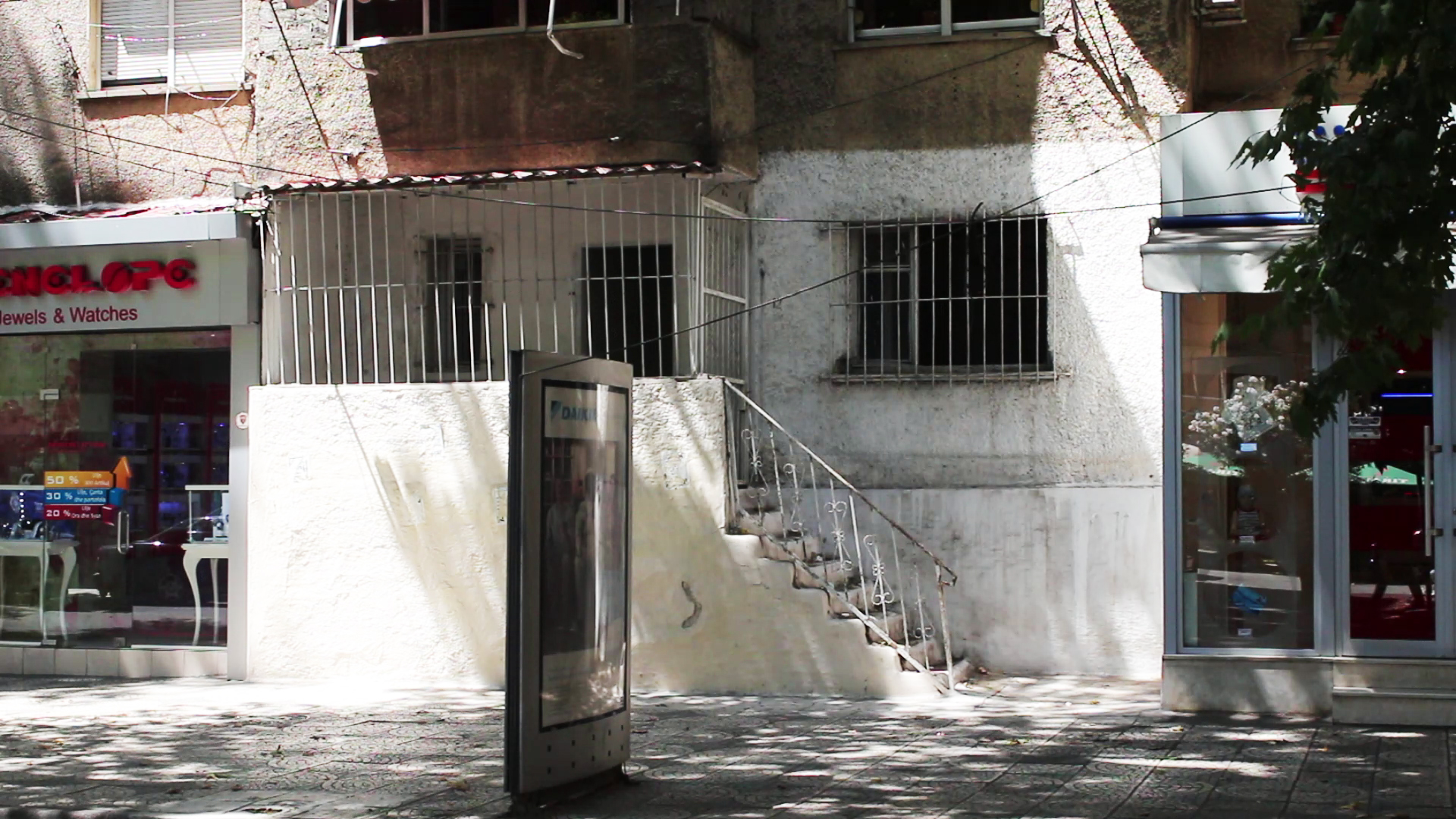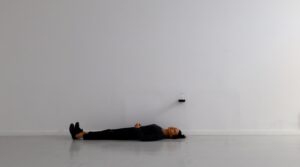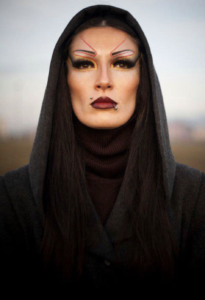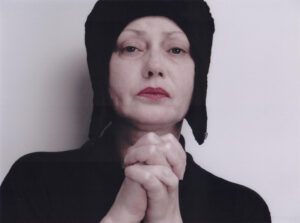Donika Çina
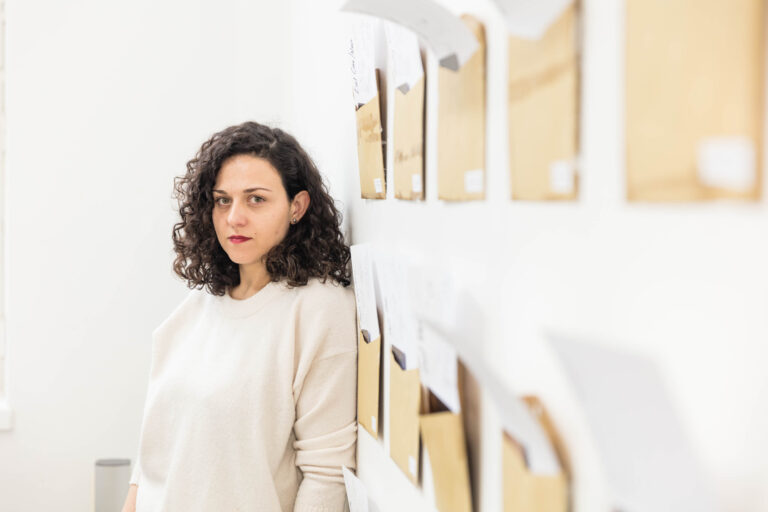
- anti-capitalism
- art intervention
- collaboration
- collectivity
- critical art
- cultural memory
- documentary
- everyday
- existential
- freedom
- gentrification
- history
- ideology
- installation
- language
- life
- marginalized
- memory
- mistake
- multimedia
- ordinary
- personal
- politics
- power relations
- process
- re-enactment
- Relations
- relationships
- remembrance
- research
- resistance
- social
- social criticism
- social engagement
- socially engaged art
- socio-political
- storytelling
- text
- trauma
- truth
- utopia
- video art
- video installation
– born in 1988 in Korça, currently lives and works in Tirana, Albania. Donika usually works in the medium of video art, video installation and performance. She graduated from the Faculty of Visual Art – Multimedia, at the Academy of Arts in Tirana and went on to study photography and video at the University of Arts and Design in Cluj-Napoca, Romania and further in the class of Candice Breitz at the University of Art in Braunschweig, Germany.
One of the most sophisticated means at the disposal of humans to get to know themselves is empathy. The capacity to forget for a moment the weight of your body and mind and to enter under someone else’s skin. To see the world with the eyes of someone else, or many others. This has always been an activity which has enchanted me. Just imagine how many conflicts could have been avoided, had we but practised this activity more often. However,… do we have a choice on our subject matter of empathy; or… are we waiting for our sight and that of the person we are empathising with to meet in a narcissistic union? Is this perhaps an expectation to re-confirm our predetermined ideas and our empathic love for ourselves?
This is the question I address to myself as soon as I start creating something, since I believe that art is, in a way, our capability to express our empathic experiences.
This is a mental exercise, which I always keep practising, since I, more often than not, work with narration; stories, real characters, myself and the people surrounding me, of which are very often the central subject matter in my works1. I became aware about the potential of empathy, initially composing a video-project based on the story of my family and of the past of my grandfather as a politician, who was sentenced to prison by the Albanian communist regime in 1946; also referring to his political convictions and the fatal impact of his decisions on other members of the family and to the sequence of history. I interviewed all those who wanted to be interviewed; I asked them to tell their story, it simultaneously being mine and our story, as Albanians. I rejoiced and suffered by way of getting under their skin, as I discovered this multitude of ideas and approaches, which differed a lot from each-other, although they were subject to similar circumstances. I put all the faces and interviews next to each-other2 and I understood that I could not direct this film; this would be the same as directing history.
What my intention was, is as follows: telling a personal political story, while being ideologically not corrupt. This is also my approach regarding art and politics overall; I think that there is a difference between making a political art and making an ideological art. The ideological art requires conviction, the political art requires liberation. I prefer to be free, while not falling under a single ideological mould. To me, life is richer and more complicated than this. I evaluate the infirmity and strength of humans through the same dimension and this is why my role in this story, and onwards in my works, is more likely affiliated to that of the moderator of narration than that of a film director.
The same enchantment to the multitudinousness within and outside us has been developed by me in my works at other occasions. Same as Pepper’s Ghost (2019)3, a video installation raising the question on the role of the artist as a public figure, peculiarly by way of using the technical mistakes and the aesthetics of the television and mass media; the cut-out and transmitted film footage pertaining to a discussion round at RTSH, where I was invited to speak about the history of video-art4.
Despite being closely linked with the film legacy, I visually always prefer my video to have a sculptural aspect and that the narration be shared by more than just one screen – I like the public to be physically active experiencing my work – still, I believe that the main reason for this is my interest with the character – this is why screens seem to me like bodies. There is always an individual at the centre of my work. The way this individual establishes his relations with the society or surrounding reality is by way of dealing with him and his history as a fragment of a context or broader background. This is why I prefer to work on projects and I never consider my work as completed.
A project of mine is developed and completed with time. I have, practically, the freedom to align the narration and search in various directions5 or translate or demonstrate the same narration in another visual medium67. It resembles more likely an opened archive of the mental map that I follow in my practice, rather than a file. None of my projects have been completed so far; there is always an open door to do something anew or to come back to the same work and, certainly, I have more than just one project that I simultaneously work with8910.
Statement written by the artist.
1Donika Çina, Untitled Donika Çina Family Tree/Side A, 2010, 45 channel video installation, installation view at Fab Gallery Tirana 2010, Courtesy of the artist2Donika Çina, Untitled Donika Çina Family Tree/Side A, 2010, 45 channel video installation-video mapping version, installation view of Ardhje Award, Zeta Gallery Tirana 2016, Courtesy of the artist
3Donika Çina, Pepper’s Ghost, 2019, Video installation, 2 monitors, teleprompter and cables, installation View of the exhibition T.I.C.A Spring AIR, Zeta Gallery Tirana 2019, Courtesy of the artist
4Donika Çina, Pepper’s Ghost, 2019, Video installation, 2 monitors, teleprompter and cables. installation View of the exhibition T.I.C.A Spring AIR, Zeta Gallery Tirana 2019, Courtesy of the artist
5Donika Çina, Untitled Donika Çina Family Tree/Side B, 2020, multichannel video installation, work in progress, Courtesy of the artist. B-side comes as the continuation of Donika Çina’s Untitled (Family Tree), a multichannel video installation consisting in an experimental documentation of the history of her family and as such of the historical changes and influences thereof on the personal lives of the members. While A-side refers to the history of her mother’s family and genealogical tree, B-side represents her father’s genealogical tree and story.
6Donika Çina, Untitled Donika Çina Family Tree/Side A Installation, 2020, Mixed media, installation view at IASPIS studios, Stockholm, Courtesy of the artist
7Donika Çina, Untitled Donika Çina Family Tree/Side A Installation, 2020, Mixed media, installation view at IASPIS studios, Stockholm, Courtesy of the artist
8Donika Çina, Surface Project, The Steady Fragment, 2017, Print on paper, Courtesy of the artist
9Donika Çina, Surface Project, The Weather Fragment, 2019, Performance with visualy impaired actors. TIA MUC KLIMA, Halle 50, Munich 2019, Courtesy of the artist
10Donika Çina, In-Between Project, BIA, 2016-present, continuous intervention in public space. Myslym Shyri St Tirana, Courtesy of the artist
– lindur në 1988 në Korçë, aktualisht jeton dhe punon në Tiranë, Shqipëri. Donika zakonisht punon në mediumin e video artit, video instalacionit dhe performancës. Ajo u diplomua në Fakultetin e Artit Vizual – Multimedia, në Akademinë e Arteve në Tiranë dhe vazhdoi të studiojë fotografi dhe video në Universitetin e Arteve dhe Dizajnit në Cluj-Napoca, Rumani dhe më tej në klasën e Candice Breitz në Universitetin e Art në Braunschweig, Gjermani.
Një nga mjetet më të sofistikuara që njeriu ka brenda vetes për të njohur botën është empatia. Aftësia për t’u shkëputur një moment nga pesha e trupit dhe mendjes tënde dhe për të hyrë në lëkurën e dikujt tjetër. Për të parë botën me sytë e dikujt tjetër, e shumë të tjerëve. Ky ka qenë gjithmonë një aktivitet që më ka mahnitur. Imagjinoni sa shumë konflikte mund të (ishin) shmangen/ur në qoftë se do të mund ta ushtronim më shpesh këtë aktivitet. Por, a e zgjedhim ne subjektin e empatisë sonë, apo mos vallë jemi duke pritur që vështrimi ynë dhe ai i njeriut me të cilin po krijojmë empati të kryqëzohen në një bashkim narcistik? A mos është kjo një pritje për të rikonfirmuar idetë tona paraprake dhe dashurinë për veten tonë empatike?
Kjo është pyetja që i drejtoj vetes sa herë nis të krijoj diçka, sepse besoj që arti është, në një farë mënyre, aftësia jonë për të shprehur eksperiencat tona empatike.
Ky është një ushtrim mendor që gjithmonë e bëj, mbi të gjitha sepse punoj me tregimtarinë; historitë, personazhet reale dhe vetja ime e njerëzit perreth meje janë shpesh subjekti qendror i punëve të mia1. U bëra e ndërgjegjshme rreth potencialit të empatisë, si fillim duke ndërtuar një video-projekt të bazuar mbi historinë e familjes sime dhe të kaluarës së stërgjyshit tim politikan të dënuar prej shtetit komunist shqiptar në 1946-en; bindjeve të tij politike dhe pasojave fatale të vendimeve të tij tek jeta e pjesëtarëve të tjerë të familjes dhe rrjedhës së historisë. I intervistova të gjithë, ata që donin të intervistoheshin. U kërkova të tregonin historinë e tyre që është edhe historia ime dhe e jona, ajo e shqiptarëve. Gëzova dhe vuajta duke hyrë në lëkurën e tyre dhe zbulova një multitudë idesh dhe qëndrimesh që ndryshonin shumë nga njëra-tjetra edhe pse kishin qenë subjekt rrethanash të ngjashme. I vendosa të gjitha fytyrat dhe intervistat përbri njëra-tjetrës2 dhe kuptova që unë nuk mund të isha unë regjisorja e këtij filmi, kjo do të ishte e njëjtë sikur të doja të bëja regjinë e historisë.
Çfarë synoja unë ishte të tregoja një histori personale politike pa qenë ideologjikisht e korruptuar. Ky është edhe qëndrimi im përsa i përket artit dhe politikës në përgjithësi. Mendoj se ka një diferencë midis të bërit art politik me të bërit art ideologjik. Arti ideologjik kërkon bindje, arti politik kërkon çlirim. Unë preferoj të jem e lirë, të mos kem një prizëm ideologjik të vetëm. Jeta për mua është më e pasur dhe më e komplikuar se kaq. I vlerësoj si dobësitë ashtu edhe forcën e njeriut njësoj, prandaj dhe roli im në këtë histori, siç shfaqet tutje në punët e mia, do t’i përafrohet më tepër atij të moderatores së narracionit se sa të regjisores së filmit.
Të njëjtën magjepsje ndaj shumëfishësisë brenda dhe jashtë nesh e kam zhvilluar edhe herë të tjera në punët e mia. Si te Pepper’s Ghost3 një video instalacion që ngre pyetje mbi rolin e artistit si figurë publike pikërisht duke përdorur gabimet teknike dhe estetikën e televizionit dhe mass medias; materialin filmik të skarcuar dhe atë të transmetuar të një paneli diskutimi në RTSH ku unë vetë isha e ftuar të flisja për historinë e videoartit4.
Vizualisht, edhe pse jam shumë e lidhur me tregimtarinë filmike, parapëlqej gjithmonë që videot e mia të kenë një aspekt skulpturor dhe që narracioni të ndahet në më shumë se një ekran – më pëlqen që publiku të jetë edhe fizikisht aktiv kur përjeton punën time – e megjithatë besoj se arsyeja kryesore është interesi im tek personazhi – prandaj dhe ekranet më ngjajnë si trupa. Në punët e mia është gjithmonë një individ në qendër. Mënyra se si ky individ ia del të futet në marrëdhënie me shoqërinë apo realitetin përreth, është duke e trajtuar historinë e tij si fragment të një konteksti apo historie më të madhe. Prandaj dhe preferoj të punoj me projekte dhe nuk i konsideroj punët e mia asnjëherë si punë të përfunduara.
Një projekt i imi zhvillohet dhe plotësohet në kohë. Si praktikë, brenda tij kam lirinë ta orientoj tregimin dhe kërkimin në drejtime të ndryshme5 ose të përkthej dhe manifestoj po të njëjtën narrativë në një medium tjetër vizual67. I ngjan më tepër një arkive të hapur të hartës mendore që une ndjek në krijimtarinë time se sa një dosjeje. Deri më tani asnjë nga projektet e mia nuk ka përfunduar, ka gjithmonë një derë të hapur për të krijuar një punë të re ose për t’iu rikthyer të njëjtës punë dhe sigurisht, kam më tepër se një projekt me të cilin punoj njëkohesisht8910.
Tekst i shkruar nga artistja.
1Donika Çina, Pa titull Donika Çina Pema familjare/Ana A, 2010, video instalacion, Pamje nga Fab Gallery Tirana, Kortezi e artistes2Donika Çina, Pa Titull Donika Çina Pema familjare/Ana A, 2010, video instalacion, Pamje nga Fab Gallery Tirana, Kortezi e artistes
3Donika Çina, Pepper’s Ghost, 2019, video instalacion, 2 monitorë, teleprompter dhe kabllo, Pamje nga ekspozita T.I.C.A Spring AIR, Zeta Gallery Tirana 2019, Kortezi e artistes
4Donika Çina, Pepper’s Ghost, 2019, video instalacion, 2 monitorë, teleprompter dhe kabllo, Pamje nga ekspozita T.I.C.A Spring AIR, Zeta Gallery Tirana 2019, Kortezi e artistes
5Donika Çina, Pa titull Donika Çina Pema familjare/Ana B, 2020, shkëputur nga video, video instalacion me disa ekrane, e pambaruar, Kortezi e artistes. B-side vjen si vazhdimësi e Pa Titull (Pema Familjare) e Donika Çinës, një video instalacion shumëkanalësh që konsiston në një dokumentacion eksperimental të historisë së familjes së saj dhe si i tillë i ndryshimeve historike dhe ndikimeve të tyre në jetën personale të anëtarëve. Ndërsa ana A i referohet historisë së familjes dhe pemës gjenealogjike të nënës së saj, ana B përfaqëson pemën dhe historinë gjenealogjike të babait të saj.
6Donika Çina, Pa Titull Donika Çina Pema familjare/Ana A, 2020, Installation, Media të përziera, Pamje nga at IASPIS studios, Stockholm, Kortezi e artistes
7Donika Çina, Pa Titull Donika Çina Pema familjare/Ana A, 2020, Installation, Media të përziera, Pamje nga at IASPIS studios, Stockholm, Kortezi e artistes
8Donika Çina, Projekti i sipërfaqes, Fragmenti i qëndrueshëm, 2017, Print në letër, Kortezi e artistes
9Donika Çina, Surface Project, Fragmenti i motit, 2019, Performancë me aktorë me aftësi të kufizuar në shikim, TIA MUC KLIMA, Halle 50, Munich, Kortezi e artistes
10Donika Çina, Projekti në mes, BIA, 2016-në vazhdim, ndërhyrje e vazhdueshme në hapësirë publike, Rr Myslym Shyri Tirana, Kortezi e artistes
- anti-capitalism
- art intervention
- collaboration
- collectivity
- critical art
- cultural memory
- documentary
- everyday
- existential
- freedom
- gentrification
- history
- ideology
- installation
- language
- life
- marginalized
- memory
- mistake
- multimedia
- ordinary
- personal
- politics
- power relations
- process
- re-enactment
- Relations
- relationships
- remembrance
- research
- resistance
- social
- social criticism
- social engagement
- socially engaged art
- socio-political
- storytelling
- text
- trauma
- truth
- utopia
- video art
- video installation
